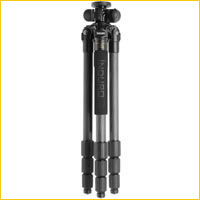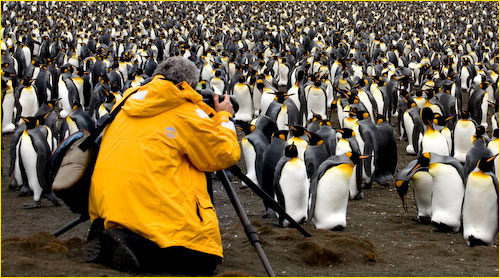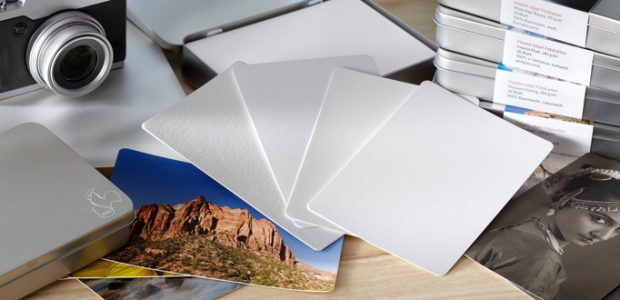
The New Kid in Town
Photographers looking for the best combination of light weight and rigidity in a tripod have always (or at least for the past 10 years) turned to carbon fibre. While there are some wooden tripods that offer equal or better dampening characteristics, CF offers the best combination of weight, rigidity and resistance to the elements.
The originator and leader in CF tripods till now, has been Gitzo. I’ve used a Gitzo 1349 tripod for about the past 8 years and it has been all over the world with me, handling medium format, large format, and 35mm equipment in conditions ranging from the deserts of Namibia to the Antarctic. All in all, it’s done a fine job, though I have had to have legs replaced at least twice due to their becoming unglued from their mounting points. I’ve also spent my fair share of time removing sand from joint threads and cursing the awkward rotating leg lock mechanism.
Now there’s an alternative high-end tripod available, and it’s from a company calledInduro. The distributor in the US is theMAC Group, and in Canada it’sGnigami. They was kind enough to loan me the model of my choice for testing during my month-longFebruary ’07 Antarctic expedition, and I ended up choosing the modelC-413for this trip.
The Induro line is manufactured in China, and consists of a large number of models in a variety of sizes, with both aluminum alloy and carbon fiber construction available. The model that I chose is at the high-end of the lineup, both in terms of size, specs, and price. It is the largest carbon fibre model in the line.

King Penguin Conference. South Georgia. February, 2007
Canon 1Ds MKII with 70-200mm f/2.8L IS lens at ISO 100
____________________________________________________________
What You Get
The 413 certainly comes well equipped – more so than any tripod I’ve yet seen. It ships in a sturdy nylon zippered case with a carry handle and attachment points for a shoulder strip. A shoulder strap is also included, and there is a swivel attachment point built on at the top of the tripod. On the strap is a small pouch containing a set of leg wrenches as well as a set of stainless steel leg spikes, which screw into the end of the legs as replacements for the normal rubber tipped feet. Just the thing for working on ice.
Indicative of the thought that went into the 413’s design is that the tripod will fit in the case with a head attached – in my case theReally Right Stuff BH55.
There is a dense foam grip attached to one of the legs, for when the tripod needs to be hand carried. There is a bubble level built into the top plate, and also a completely useless compass. (This is a real bit of silliness that should be removed on the tripod’s next iteration).
The tripod has a reversible center column, and in one of the tripod’s few design omissions, there is no optional mounting plate that allows for the column to be completely removed as there is with Gitzo tripods. The column locking collar also will not completely lock the center column in place, and a very strong push downwards on the head will move it, though it needs to be said that the amount of force that will do this is far beyond the weight of even the largest camera and lens combination likely to be used.
____________________________________________________________
Leg Construction
After many years of suffering with Gitzo tripod legs that rotate when you turn them, making unscrewing legs a real pain, that company has finally in 2006 started shipping a new line of tripods with non-rotating legs. They must have seen the Induros coming, because this new line of tripods also feature non-rotating legs. This means that opening and closing a leg segment is a simple matter of grabbing one of the large twist collars. These are claimed to offer a high degree of moisture and dirt / sand resistance. Nicely done.
As with Gitzo tripods, the legs have notched positioning stops, except that the locking piece on the Induros are much fatter and easier to grab. There is a spring-loaded hook on the bottom of the center column to which one can attach a bag or other object for additional weight and stability.
The legs themselves are made from 8 ply carbon fiber, and are claimed by Induro to be 60% stronger than their competitors (read Gitzo).
____________________________________________________________
In the Field

Me and a Few Friends, with the Induro C413
Specs are one thing, real-world performance another. The Induro did well in Antarctica, but not quite as well as I would have wished. The failures were just in a couple of areas. Firstly, the tripod sling mounting point broke of the first day of use. It simply does not appear robust enough for heavy duty use. Secondly, the vibration from sitting at the bottom of a Zodiac for just 15 minutes was enough to vibrate loose the interchangable metal spike feet. After losing one I belatedly discovered that the provided wrench can be used to firmly lock them in place. Finger tightening isn’t sufficient. User error.
That was it for points of failure. Otherwise the Induro C413 held up very well to some pretty heavy-duty field use. The large leg release grips were found to work well, even when wet or cold.
My biggest complaint is the lack of a top plate so that the center column can be removed. As seen in the above snapshot it is often necessary to get very low when shooting, and the provided column prevents this. A shorter center column is apparently under development.
____________________________________________________________
Conclusion
The new Induro Carbon Fibre tripods are a very worthwhile addition to the marketplace. Professional photographers now have a strong alternative to the Gitzo line, and Induro will likely garner some significant marketshare.
Thanks toVistekfor their loan of the C413 for this trip.
(Memo to Ron. Sorry for the smell of the tripod. I washed off as much penguin guano as I could. Really I did!)
You May Also Enjoy...
Hahnemühle Paper Specialty Products
In the last article published Mark Segal did a great job explaining the Hahnemühle specialty paper products. I am all about making prints and Getting

